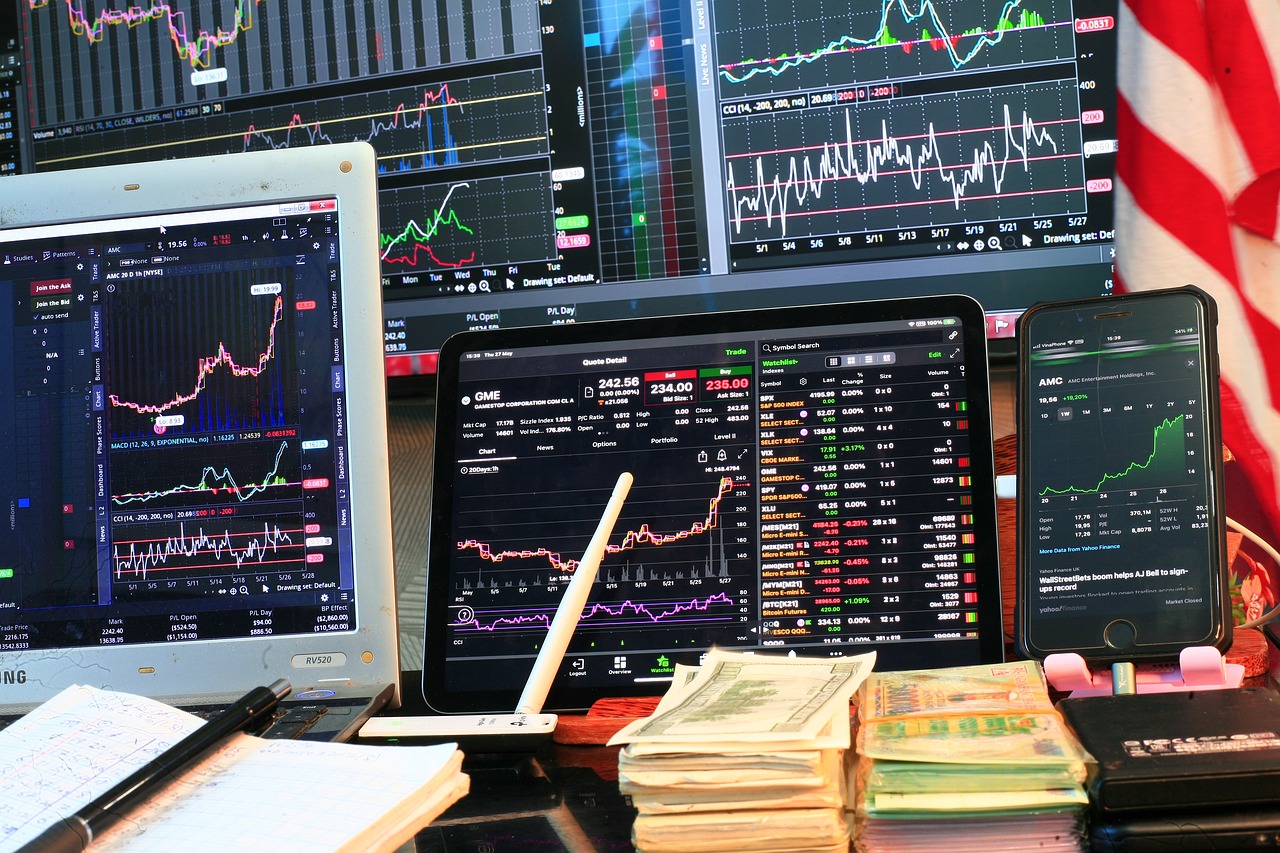How to Use ATR for Position Sizing
Welcome to the exciting world of trading, where understanding and managing risk is as crucial as making profits. One of the most powerful tools in a trader's toolkit is the Average True Range (ATR). This article will dive deep into how to effectively use ATR for position sizing, ensuring that you not only protect your capital but also enhance your trading strategies. So, buckle up as we explore the ins and outs of ATR and its significance in the trading arena!
The Average True Range (ATR) is a volatility indicator that measures market fluctuations. It was developed by J. Welles Wilder Jr. and is widely used by traders to assess how much the price of an asset can move over a certain period. The calculation of ATR involves three key components: the current high, the current low, and the previous close. By taking the greatest of these values, traders can determine the true range and average it over a specified number of periods. This gives a clearer picture of market volatility, allowing for better trading decisions.
Now, let’s talk about position sizing. Why is it so important? Well, think of it this way: if trading were a game of poker, position sizing would be your stack of chips. If you bet too much on one hand, you could easily find yourself out of the game. Proper position sizing acts as a safety net, protecting your capital while allowing you to take calculated risks. It can significantly improve your overall trading performance and help you stay in the game longer.
Effective risk management involves determining how much capital to risk on each trade. Here are some key principles to consider when establishing your risk tolerance:
- Know Your Limits: Understand how much you are willing to lose on a single trade.
- Set a Maximum Drawdown: Decide on a percentage of your capital that you are comfortable losing before pulling back.
- Be Consistent: Stick to your risk management rules, regardless of market conditions.
By adhering to these principles, you can create a robust risk management strategy that aligns with your trading goals.
Understanding your risk tolerance is essential for deciding position sizes. It’s like knowing your own limits before jumping into a deep pool. To assess your personal risk levels, consider factors such as your financial situation, trading experience, and emotional resilience. Ask yourself questions like: How much can I afford to lose? What keeps me up at night when trading? Aligning your risk tolerance with your trading goals will help you make more informed decisions.
The risk-reward ratio is another critical element in position sizing. This ratio helps you balance potential profit against potential loss. For example, if you’re risking $100 to make $300, your risk-reward ratio is 1:3. It’s essential to calculate this ratio before entering a trade to ensure that the potential reward justifies the risk. A favorable risk-reward ratio can significantly enhance your profitability over time.
Now that we’ve covered the basics of risk management, let’s talk about how to integrate ATR into your position sizing strategy. By using ATR values, you can determine appropriate position sizes based on market volatility. The formula is straightforward: Divide your capital at risk by the ATR value. For instance, if you have a trading account of $10,000 and you're willing to risk 2% on a trade, your risk amount is $200. If the ATR of the asset is $2, you would divide $200 by $2, giving you a position size of 100 shares. This method allows you to adjust your position size according to the market's volatility, ensuring that you remain within your risk tolerance.
Understanding theoretical concepts is essential, but practical examples solidify learning. Let’s look at some real-world scenarios demonstrating how to apply ATR for position sizing effectively.
Forex trading is known for its high volatility, making ATR particularly useful. For instance, consider a trader analyzing the EUR/USD pair. If the ATR is 0.0100, and the trader is willing to risk 1% of their $10,000 account, they can calculate their position size as follows: Risk amount is $100, and with an ATR of 0.0100, the position size would be 10,000 units. This approach ensures that the trader is sizing their position in accordance with the market's volatility.
Stocks also exhibit varying levels of volatility. For example, a trader looking at a tech stock with an ATR of $3.00 and a $20,000 account might decide to risk 2%. This means they are willing to risk $400. Using the ATR, they can calculate their position size: $400 divided by $3.00 gives them a position size of approximately 133 shares. This method provides a dynamic way to adjust position sizes based on real-time market conditions.
Q: What is the Average True Range (ATR)?
A: ATR is a volatility indicator that measures market fluctuations, helping traders understand how much an asset's price can move over a specific period.
Q: How do I calculate my position size using ATR?
A: To calculate position size, divide your risk amount by the ATR value. This helps you adjust your position size according to market volatility.
Q: Why is position sizing important in trading?
A: Proper position sizing is crucial for risk management. It helps protect your capital and enhances your overall trading performance.
Q: How can I determine my risk tolerance?
A: Assess your financial situation, trading experience, and emotional resilience to understand your risk tolerance better.

Understanding ATR
The Average True Range (ATR) is a powerful volatility indicator that traders use to measure market fluctuations. Developed by J. Welles Wilder Jr., ATR provides insights into how much an asset's price is expected to move, which can help traders make informed decisions about their trades. But what exactly does this mean? In simple terms, ATR tells you how volatile an asset is, allowing you to adjust your trading strategy accordingly.
To calculate ATR, you need to consider the following three components for each trading period:
- Current High - Current Low: This measures the range of the price movement within the current period.
- Current High - Previous Close: This shows how much the price has moved compared to the last closing price.
- Current Low - Previous Close: This indicates the downward movement from the previous close.
Once you have these values, ATR is calculated by taking the average of these ranges over a specified number of periods, typically 14. The formula can be summarized as:
ATR (Previous ATR * (n - 1) + Current TR) / n
Where TR is the True Range, and n is the number of periods. By averaging these values, ATR smooths out the volatility, giving you a clear picture of the asset's price movement over time.
Understanding ATR is crucial for traders because it helps in making informed decisions about position sizing. When the ATR value is high, it indicates that the market is experiencing significant volatility. Conversely, a low ATR suggests a more stable market. This knowledge allows traders to adjust their position sizes based on the current market conditions, helping to manage risk effectively.
Incorporating ATR into your trading strategy can significantly improve your chances of success. For instance, if you notice that the ATR for a particular asset has increased, it might be wise to decrease your position size to account for the higher risk. On the other hand, if the ATR is low, you might feel more comfortable increasing your position size, assuming that the risk is manageable.
In summary, ATR is not just a number; it's a vital tool that can guide your trading decisions. By understanding how to calculate and interpret ATR, you can enhance your trading strategies, manage risk more effectively, and ultimately improve your trading performance.

Why Position Sizing Matters
When it comes to trading, many people focus on finding the right entry and exit points, but they often overlook a critical aspect that can make or break their trading success: position sizing. Position sizing is essentially about determining how much of your capital you should allocate to a particular trade. It’s like deciding how much of your pizza you’re willing to eat in one sitting—too much, and you might feel sick; too little, and you might leave hungry. Finding that sweet spot is crucial for maintaining a healthy trading strategy.
Proper position sizing is vital for risk management. Imagine you're sailing a boat on turbulent waters; if you don’t know how much sail to put up, you could capsize. Similarly, if you risk too much of your trading capital on a single position, you might find yourself in a precarious situation where one bad trade could wipe out a significant portion of your account. This is why understanding how much to risk on each trade is not just a good idea; it’s essential.
Another reason why position sizing matters is that it can help you improve your overall trading performance. Think of it as a safety net that allows you to stay in the game longer. By managing your risk effectively, you can withstand the natural ups and downs of trading without blowing up your account. This way, you give yourself the opportunity to learn, adapt, and grow as a trader. After all, trading is a marathon, not a sprint, and maintaining a consistent approach can yield better long-term results.
To illustrate the importance of position sizing, consider the following table that outlines different scenarios based on varying position sizes:
| Position Size | Risk per Trade (%) | Potential Loss on $10,000 Account |
|---|---|---|
| 1% ($100) | 1% | $100 |
| 2% ($200) | 2% | $200 |
| 5% ($500) | 5% | $500 |
| 10% ($1,000) | 10% | $1,000 |
This table clearly shows how different position sizes can lead to varying levels of risk. While risking 1% might seem conservative, it allows you to survive multiple losing trades without significant damage to your account. On the other hand, risking 10% can be perilous; a few bad trades could leave you with a fraction of your original capital.
In conclusion, understanding why position sizing matters is essential for any trader looking to thrive in the markets. It’s not just about making profits; it’s about protecting your capital and ensuring that you can continue trading even in the face of adversity. So, the next time you plan a trade, ask yourself: how much am I willing to risk, and does that align with my overall trading strategy?
- What is the best position size for a trader? The best position size varies based on individual risk tolerance, trading strategy, and account size. A common guideline is to risk no more than 1-2% of your total capital on a single trade.
- How can I calculate my position size? You can calculate your position size using the formula: Position Size (Account Risk Amount) / (Trade Risk per Share). This helps you determine how many shares or contracts to buy.
- Why is risk management important in trading? Risk management is crucial because it helps you protect your capital, maintain emotional control, and improve your overall trading performance.

Risk Management Principles
When it comes to trading, understanding is like having a solid compass in uncharted waters. It guides you through the unpredictable waves of the market, helping you navigate towards profitability while minimizing potential losses. One of the fundamental aspects of risk management is determining how much of your capital you are willing to risk on each trade. This isn't just a shot in the dark; it's a calculated decision that can make or break your trading career.
First off, it’s essential to establish a clear risk tolerance. This involves assessing your comfort level with potential losses and the amount of capital you can afford to lose without significantly impacting your lifestyle. Think of it as knowing your limits in a game of poker; you wouldn't bet your entire stack on a single hand unless you're feeling particularly lucky. Similarly, in trading, you need to be aware of how much you're willing to wager on each trade.
Another crucial principle is the 1% rule. This guideline suggests that you should never risk more than 1% of your trading account on a single trade. For instance, if your trading account has $10,000, you should limit your risk to $100 per trade. This approach helps in preserving your capital over the long term, allowing you to withstand a string of losses without depleting your account. The table below illustrates how different account sizes can affect your risk per trade:
| Account Size | 1% Risk |
|---|---|
| $5,000 | $50 |
| $10,000 | $100 |
| $20,000 | $200 |
| $50,000 | $500 |
Additionally, you should consider the reward-to-risk ratio when planning your trades. This ratio compares the potential profit of a trade to the potential loss. A common target is a ratio of at least 2:1, meaning you aim to make $2 for every $1 you risk. This principle is not just about maximizing profits; it’s about ensuring that even if you lose some trades, the wins will outweigh the losses, keeping you in the game longer.
To sum it up, effective risk management involves a mix of knowing your risk tolerance, adhering to the 1% rule, and calculating your reward-to-risk ratio. By integrating these principles into your trading strategy, you can better manage your capital, reduce anxiety, and ultimately improve your trading performance. Remember, trading is not just about making money; it's about managing your losses wisely.

Defining Your Risk Tolerance
Defining your risk tolerance is a crucial step in your trading journey. It's like knowing how spicy you can handle your food before you take that first bite. Some traders thrive on the thrill of high-risk investments, while others prefer a more conservative approach. Understanding where you stand on this spectrum is essential for making informed trading decisions that align with your personal comfort levels.
To effectively assess your risk tolerance, consider the following factors:
- Financial Situation: Your current financial health plays a significant role in determining how much risk you can afford to take. If you have a stable income and a solid emergency fund, you may be more willing to take on higher risks.
- Investment Goals: What are you aiming for? Are you looking for quick gains, or are you in it for the long haul? Your goals will influence how much risk you should be comfortable with.
- Time Horizon: How long do you plan to stay invested? If you have a longer time horizon, you might be able to weather short-term volatility better than someone looking for immediate returns.
- Emotional Factors: This is perhaps the most overlooked aspect. Are you someone who can stay calm during market downturns, or do you panic easily? Your emotional response to losses can significantly impact your risk tolerance.
Once you've analyzed these factors, it's helpful to create a personal risk profile. Think of it as a roadmap that guides your trading decisions. For example, if you identify yourself as a moderate risk-taker, you might allocate a certain percentage of your capital to high-risk trades while keeping the rest in safer investments. This balance allows you to pursue potential gains without putting your entire capital at risk.
Additionally, consider using a risk assessment questionnaire to quantify your risk tolerance. These questionnaires typically ask about your financial situation, investment experience, and emotional responses to market changes. The results can provide you with a clearer picture of your risk profile, making it easier to determine appropriate position sizes in your trading strategy.
In summary, defining your risk tolerance is not a one-size-fits-all approach. It's a personal journey that requires self-reflection and honest assessment of your financial situation, investment goals, and emotional resilience. By understanding your risk tolerance, you can make more informed decisions that not only protect your capital but also enhance your trading performance.

Using a Risk-Reward Ratio
When it comes to trading, understanding the risk-reward ratio is absolutely essential. This ratio is a simple yet powerful tool that helps traders evaluate the potential profitability of a trade in relation to the risk they are taking on. To put it simply, the risk-reward ratio compares the amount of money you stand to lose if the trade goes against you to the amount you could gain if it goes in your favor. For instance, if you risk $100 to potentially make $300, your risk-reward ratio is 1:3. This means for every $1 you risk, you could earn $3 if the trade is successful.
Using this ratio effectively allows traders to make informed decisions about their positions. A good rule of thumb is to aim for a risk-reward ratio of at least 1:2, meaning you should expect to make at least twice as much as you are willing to lose. This can significantly improve your chances of profitability over time, as even if you only win 50% of your trades, you could still come out ahead. Think of it like planting seeds in a garden; if you plant two seeds for every one you expect to grow, you’re more likely to harvest a bountiful crop.
However, calculating the risk-reward ratio isn't just about the numbers; it's also about your trading strategy and market conditions. You need to consider factors such as market volatility, which is where the Average True Range (ATR) comes into play. By incorporating ATR into your calculations, you can adjust your risk-reward ratio based on the current volatility of the market. This ensures that your expectations align with the market conditions, allowing you to set more realistic targets and stop-loss levels.
To illustrate this further, let’s say you’re trading a stock that has an ATR of $2. If you decide to enter a trade at $50, you might set your stop-loss at $48 (risking $2) and your take-profit target at $54 (potentially gaining $4). This gives you a risk-reward ratio of 1:2, which is favorable. If the ATR were to increase to $3, you might adjust your stop-loss to $47, keeping your risk consistent while increasing your potential reward if the trade goes well.
In summary, the risk-reward ratio is a crucial aspect of trading that helps you manage your expectations and align your trades with your overall strategy. By combining this with the insights provided by ATR, you can create a robust framework for determining position sizes and making informed trading decisions. Just remember, it’s not just about how much you could gain, but also about how much you’re willing to risk. Balancing these two factors is key to successful trading.

Integrating ATR into Position Sizing
When it comes to trading, one of the most critical aspects is knowing how to size your positions effectively, and this is where the Average True Range (ATR) comes into play. By integrating ATR into your position sizing strategy, you can make informed decisions that align with the market's current volatility. But how do you actually do this? Let's break it down.
First off, it’s essential to understand that ATR is not a directional indicator; rather, it measures the volatility of an asset. This means that when the ATR is high, the market is experiencing significant price movements, and when it is low, the market is relatively stable. By using ATR, you can adjust your position size based on the volatility of the market, which is crucial for managing risk effectively.
To integrate ATR into your position sizing, follow these steps:
- Calculate the ATR: Start by determining the ATR for the asset you are trading. Most trading platforms provide this as a built-in indicator. You can set the period for the ATR calculation, typically 14 days, to get a sense of the average volatility over that timeframe.
- Determine Your Risk Per Trade: Decide how much of your trading capital you are willing to risk on a single trade. A common rule is to risk no more than 1-2% of your total capital.
- Calculate Position Size: Use the ATR value to calculate your position size. The formula is simple: Position Size (Account Risk / (ATR * Multiplier)). The multiplier can be a factor you choose based on your trading strategy and risk tolerance.
For example, if your account balance is $10,000, and you decide to risk 1% on a trade, your risk amount is $100. If the ATR for the asset is 2.5, and you choose a multiplier of 1, your position size would be:
| Account Risk | ATR | Multiplier | Position Size |
|---|---|---|---|
| $100 | 2.5 | 1 | 40 Shares |
This means you would buy 40 shares of the asset, allowing you to manage your risk effectively based on the current market volatility. By adjusting your position size according to ATR, you’re not only safeguarding your capital but also positioning yourself to take advantage of market movements without overexposing yourself.
Moreover, integrating ATR into your trading strategy allows for a more dynamic approach. As market conditions change, so does your position size. This adaptability is vital in a world where market conditions can shift rapidly. Think of it as a ship adjusting its sails according to the wind; you want to be able to navigate the turbulent waters of trading with agility and confidence.
In conclusion, by incorporating ATR into your position sizing strategy, you can enhance your trading decisions and manage risk more effectively. Remember, the goal is not just to make profits but to protect your capital while navigating the unpredictable seas of the financial markets.

Practical Examples of ATR Usage
Theoretical concepts can only take you so far in trading; it’s the practical application that truly solidifies your understanding. When it comes to the Average True Range (ATR), using it effectively can transform your trading strategy. Let's dive into some real-world scenarios to see how ATR can be utilized for position sizing in different markets. This practical approach not only enhances your trading decisions but also helps in managing risk more effectively.
To illustrate the power of ATR, we can look at two distinct markets: Forex and stock trading. Each market has its own unique characteristics and volatility patterns, making it essential to adapt your position sizing strategy accordingly. By understanding how ATR functions in these markets, you can make informed decisions that align with your trading goals.
Forex trading is known for its high volatility, which can be both an opportunity and a risk. Let’s say you're trading the EUR/USD pair, which has an ATR of 0.0050 (50 pips). If your account balance is $10,000 and you decide to risk 1% of your capital on a single trade, that means you’re willing to risk $100. Using the ATR, you can determine your position size as follows:
| Parameter | Value |
|---|---|
| Account Balance | $10,000 |
| Risk Percentage | 1% |
| Dollar Risk | $100 |
| ATR (in pips) | 50 |
| Position Size (in units) | 2 |
In this example, you would divide your dollar risk ($100) by the ATR (50 pips), resulting in a position size of 2 standard lots. This means you’re effectively sizing your position based on the market's volatility, which helps in managing your risk more efficiently.
Now, let’s shift gears and examine stock trading. Imagine you’re considering buying shares of a tech company, XYZ Corp, which has an ATR of $2.00. With the same account balance of $10,000 and a risk tolerance of 1%, you’re again looking to risk $100. Here’s how you would calculate your position size:
| Parameter | Value |
|---|---|
| Account Balance | $10,000 |
| Risk Percentage | 1% |
| Dollar Risk | $100 |
| ATR (in dollars) | $2.00 |
| Position Size (in shares) | 50 |
Here, you would take your dollar risk ($100) and divide it by the ATR ($2.00), giving you a position size of 50 shares. This method ensures that your position is appropriately sized according to the stock's volatility, which can help you avoid significant losses while still allowing for potential gains.
In both examples, using ATR for position sizing allows traders to adapt to market conditions dynamically. By understanding the volatility of the asset you are trading, you can make more informed decisions that align with your overall risk management strategy. This not only protects your capital but also enhances your trading performance over time.
- What is the Average True Range (ATR)?
ATR is a volatility indicator that measures the degree of price movement over a specific period, helping traders assess market volatility. - How does ATR assist in position sizing?
ATR provides a quantifiable measure of volatility, allowing traders to determine how much capital to risk based on market conditions. - Can ATR be used in all markets?
Yes, ATR can be applied to various markets, including Forex, stocks, and commodities, making it a versatile tool for traders. - What is a good risk-reward ratio?
A common risk-reward ratio is 1:2, meaning for every $1 you risk, you aim to make $2 in profit.

Case Study: Forex Trading
Forex trading, characterized by its rapid price movements and high volatility, presents unique challenges and opportunities for traders. Understanding how to effectively utilize the Average True Range (ATR) can be a game-changer in this dynamic environment. By measuring market volatility, ATR provides traders with valuable insights into how much to risk on each trade, ultimately influencing position sizing.
For instance, consider a trader who is analyzing a currency pair, say EUR/USD. After calculating the ATR for this pair, they find that the ATR is currently at 0.0050, which indicates that the price typically moves 50 pips over a given period. This information is crucial because it helps the trader determine how much room to allow for price fluctuations when entering a position.
Let’s say this trader has a capital of $10,000 and is willing to risk 2% of their capital on a single trade. This means they are prepared to risk $200. Using the ATR value, the trader can calculate their position size as follows:
| Parameter | Value |
|---|---|
| Account Balance | $10,000 |
| Risk Percentage | 2% |
| Risk Amount | $200 |
| ATR (in pips) | 50 pips |
| Position Size (in lots) | 0.4 lots |
To determine the position size, the trader divides the risk amount by the ATR value multiplied by the pip value (assuming 1 pip equals $10 for a standard lot). In this case:
Position Size Risk Amount / (ATR * Pip Value) Position Size $200 / (50 pips * $10) Position Size 0.4 lots
This calculation indicates that the trader can confidently enter a position of 0.4 lots on the EUR/USD pair, knowing that they are adequately managing their risk relative to market volatility. By using ATR in this way, traders can adjust their position sizes according to changing market conditions, ensuring that they are not overexposed during highly volatile periods.
Moreover, as market conditions evolve, the ATR will also fluctuate. This means that traders must continuously monitor ATR and adjust their position sizes accordingly. If the ATR increases, indicating higher volatility, the trader might choose to reduce their position size to maintain the same level of risk. Conversely, if the ATR decreases, they could potentially increase their position size, taking advantage of a more stable market.
In conclusion, leveraging ATR for position sizing in Forex trading is not just about managing risk; it’s about strategically positioning oneself to capitalize on market movements. As traders become more adept at using ATR, they can navigate the complexities of the Forex market with greater confidence and precision.

Case Study: Stock Trading
When it comes to stock trading, understanding volatility is as crucial as knowing your favorite coffee order. Just like you wouldn't want to sip on a bitter brew, you certainly don’t want to dive into the stock market without a solid grasp of how Average True Range (ATR) can inform your position sizing. Let’s break down how ATR can be a game-changer for traders navigating the sometimes choppy waters of the stock market.
Imagine you’re eyeing a stock that has been all over the place lately. One minute it’s soaring, and the next, it’s plummeting. This is where ATR comes into play. By measuring the average range of price movement over a specific period, ATR gives you a clearer picture of how much a stock typically fluctuates. For example, if a stock has an ATR of $2, it means that, on average, it moves up or down by $2 each day. This information is invaluable when you’re deciding how much capital to risk on a trade.
Let’s say you have a trading account with $10,000 and you’re comfortable risking 2% of your capital on a single trade. This means you’re willing to risk $200. If the ATR of the stock you're interested in is $2, you can calculate your position size. Here’s how:
| Account Size | Risk Percentage | Risk Amount | ATR | Position Size |
|---|---|---|---|---|
| $10,000 | 2% | $200 | $2 | 100 shares |
In this scenario, you would buy 100 shares of the stock. Why? Because if the stock moves against you by the ATR amount of $2, you would incur a loss of $200, which aligns perfectly with your risk tolerance. This strategy not only helps you manage your risk effectively but also allows you to take advantage of potential price movements without overexposing your account.
However, it’s essential to remember that while ATR is a fantastic tool for position sizing, it’s not the only factor you should consider. Market conditions, news events, and your personal trading strategy all play significant roles in how you make decisions. For instance, during earnings season, stocks can experience heightened volatility, which might lead you to adjust your position sizes accordingly.
In summary, using ATR for position sizing in stock trading is like having a roadmap in a city you’ve never visited. It guides you through the twists and turns of the market, helping you make informed decisions that align with your risk tolerance. By understanding and applying ATR, you can enhance your trading strategy, protect your capital, and ultimately improve your performance. So, the next time you're contemplating a trade, remember to check the ATR—it might just save you from a bumpy ride!
- What is ATR? ATR stands for Average True Range, a technical analysis indicator that measures market volatility.
- How is ATR calculated? ATR is calculated by taking the average of the true ranges over a specified number of periods.
- Why is position sizing important? Proper position sizing helps manage risk, ensuring you don't lose more than you can afford on a trade.
- Can ATR be used for all types of trading? Yes, ATR can be applied to various trading styles, including day trading, swing trading, and long-term investing.
Frequently Asked Questions
- What is the Average True Range (ATR)?
The Average True Range (ATR) is a technical indicator that measures market volatility. It calculates the average range between the high and low prices over a specific period, providing traders with insights into how much a market might move. This is crucial for making informed trading decisions.
- Why is position sizing important in trading?
Position sizing is vital for managing risk effectively in trading. It helps determine how much capital to allocate to each trade, ensuring that you don't overexpose yourself to losses. By using proper position sizing, traders can protect their capital and enhance their overall trading performance.
- How can I define my risk tolerance?
Defining your risk tolerance involves assessing your financial situation, trading goals, and emotional capacity to handle losses. It’s about understanding how much you're willing to lose on a trade without affecting your overall financial health. This self-awareness is key to successful trading.
- What is a risk-reward ratio and how do I calculate it?
The risk-reward ratio compares the potential profit of a trade to the potential loss. To calculate it, divide the expected profit by the potential loss. A favorable risk-reward ratio helps ensure that your winning trades outweigh your losing ones, contributing to long-term profitability.
- How do I integrate ATR into my position sizing strategy?
To integrate ATR into your position sizing, first calculate the ATR value for the asset you're trading. Then, determine how much risk you're willing to take per trade. By dividing your risk amount by the ATR, you can find the appropriate position size that aligns with market volatility.
- Can you provide an example of using ATR in Forex trading?
Sure! If the ATR for a currency pair is 50 pips and you decide to risk $100 on a trade, you would calculate your position size by dividing your risk amount by the ATR value. This helps you determine how many units to trade, ensuring you are well-positioned for market fluctuations.
- How does ATR apply to stock trading?
In stock trading, ATR can help you gauge the volatility of a stock. For instance, if a stock has a high ATR, you might choose to reduce your position size to manage risk effectively. Conversely, if the ATR is low, you may feel more confident in increasing your position size, as the stock is less volatile.



















